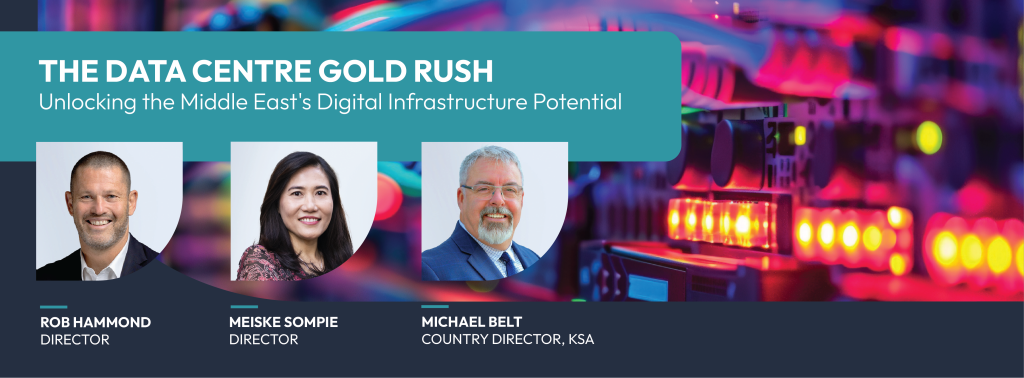By Rob Hammond, TBH Director & Global Data Centre Lead; Meiske Sompie, TBH Director overseeing Asia operations and Michael Belt, Country Director for Saudi Arabia
This article was first published in the August 2025 issue of Construction Week Middle East.
The Middle East is entering one of the most significant phases of digital infrastructure growth in its history. Giga-scale data centre initiatives, particularly in Saudi Arabia, are central to national strategies aimed at economic diversification, digital transformation and positioning the region as a global hub for cloud services and hyperscale computing. The scale is unprecedented, with billions of dollars committed and capacity targets that aim to position the region among the world’s leaders in digital infrastructure.
For investors, developers, and delivery partners, the opportunity is immense. But as with any gold rush, success depends not just on being first, but on moving strategically: laying the right foundations, building capability, and drawing on lessons learned from other global markets to avoid the common pitfalls of rapid expansion.
A Global Boom, Now Focused on the Gulf
Over the past two decades, hyperscale development has evolved from niche projects to one of the fastest-growing sectors in global infrastructure. The United States led the initial wave, as technology giants built facilities far larger than traditional server farms. Europe followed as cloud demand accelerated, and Asia and Australia soon became key growth regions, where markets like Singapore and Japan drove innovation in modular construction, stakeholder coordination and regulatory navigation.
Today, attention is firmly fixed on the Gulf. Backed by over US $70 billion in planned investment, led by Saudi Arabia’s Vision 2030, the region is bypassing the gradual scaling seen elsewhere and moving straight to 300-megawatt to one-gigawatt campuses. The opportunities to capitalise on this surge are significant —but so are the risks.
“Few regions have launched hyperscale buildouts at this size and speed from the outset,” says Rob Hammond, Director and Global Data Centre Lead at TBH, a consultancy specialising in planning and delivering complex infrastructure projects worldwide. “And when you’re dealing with giga-scale projects, with multiple delivery partners and global supply chains already stretched, the margin for error is minimal.”
Avoiding Common Bottlenecks
Each region’s data centre boom has followed a familiar trajectory. Capital pours in, timelines tighten, and supply chains strain as projects compete for the same contractors and components. Even the most mature regions, from the United States to Europe, have faced delays caused by power and water constraints, regulatory bottlenecks and a shortage of skilled delivery teams.
TBH has supported hyperscale delivery across all these regions, experience that Hammond says gives the firm a clear view of how to anticipate these risks and adapt proven strategies for the Gulf’s ambitious pipeline.
“We’ve seen how quickly developments can stall when risks aren’t identified early,” Hammond notes. “From supply chain bottlenecks to utility integration, the challenges repeat across markets. The difference is that here, the stakes are higher and timelines shorter, so having proven systems and experienced teams in place from day one is critical.”
One strategy helping to reduce these pressures is the adoption of standardised, modular designs. Components are manufactured offsite and rapidly assembled on location, cutting reliance on local construction resources and improving delivery certainty.
Lessons from Asia and Australia
Asia’s rapid expansion offers some of the most relevant insights for the Gulf. In markets like Singapore, Hong Kong and Jakarta, developers faced a sudden influx of capital, tight delivery timelines and complex approval landscapes. Success relied on quickly identifying capable contractors, securing utilities, and working closely with governments to fast-track infrastructure upgrades, all while balancing community and environmental concerns.
“In dense urban environments, regulatory hurdles are high and every stage must move quickly,” says Meiske Sompie, TBH Director overseeing operations across Asia. “Meeting these requirements involves close coordination with multiple stakeholders, from government agencies to utilities and telcos, while maintaining momentum across the programme. Modular delivery, disciplined design freeze management and proactive interface planning have been critical to success.”
Australia, meanwhile, provides a benchmark for risk-informed planning. Its mature regulatory frameworks and disciplined delivery culture have allowed TBH to help developers implement delay analysis, claims avoidance and quality-led controls; practices that keep large developments resilient even under intense scrutiny.
Building Certainty Into Giga-Scale Delivery
As giga-scale initiatives accelerate, coordinating multiple contractors, government agencies and utilities, often within compressed delivery windows, emerges as one of the biggest challenges. This is where integrated project controls, robust risk frameworks and interface management play a decisive role.
“We’ve been part of the Middle East’s delivery landscape for almost two decades, so we understand both the opportunities and the pressure points,” says Michael Belt, TBH’s Country Director for Saudi Arabia. “What sets us apart is perspective. We’ve supported projects from inception through to disputes and closeout, lessons we continuously feed back into new programmes.”
Fulfilling the region’s hyperscale ambitions, from smart cities to AI integration and national infrastructure, demands delivery models capable of supporting vast volumes of secure, high-capacity data. For investors and delivery partners in the Gulf, the rewards are substantial; but only if capability keeps pace with capital.
With 60 years of global experience, including 20 years in the Middle East, TBH is helping stakeholders navigate the complexity and deliver these giga-scale programmes with confidence.
Experience, Belt believes, will be the ultimate differentiator. “While some are still finding their footing, we’ve built a strong foundation through years of hands-on delivery in Saudi Arabia,” he says. “We’re now working with international partners entering the Gulf market, helping them adapt governance models, align with national frameworks, and engage the right stakeholders. Our longstanding relationships and regional insight allow us to streamline the process, minimize hurdles and accelerate time to market.”
“Everyone sees the opportunity,” Belt adds. “But long-term success will belong to those who not only move fast, but build the systems, relationships and delivery models to stay on track, at scale and over time.”

